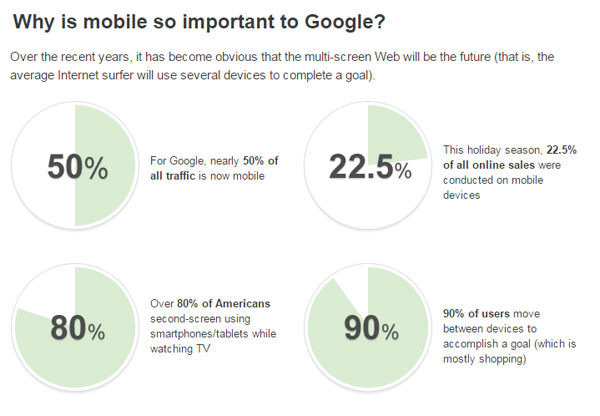There is no denying it anymore — If you haven’t already converted your website into a mobile responsive format, there’s not much more time to wait before Google’s massive April 21st update. Over the past few years, mobile traffic has seen a tremendous growth and as of last year it has even surpassed desktop traffic. As staggering as this statistic is, most businesses still haven yet to convert to a responsive website design. When mobile traffic visits a website that isn’t responsive it results in a horrible user experience, and almost always results in a lost opportunity at converting that visitor into a customer.

You can check if your website qualifies as mobile friendly by trying out Google’s Mobile-Friendly test tool using the link below.
Free Google Mobile Friendly Test
Mobile Vs. Responsive — What is the difference?
When catering to mobile devices there are two options to look at. First, a separate mobile site, which is in addition to your regular website. This design will typically work for the majority of mobile devices but it still doesn’t offer the flexibility to adjust to any screen size. Also, having two websites with the same content can cause issues or penalties based on having duplicate content. In truth, a separate mobile site can be a real SEO nightmare, and is not a suggested course of action for your organization.
With a responsive design, you only have one website that will automatically adjust to any screen on any device. This ensures that every visitor, whether on mobile devices, tablets, laptops or desktops, will have a great user experience.
5 Reasons You Need a Responsive Website Design Now
 Your mobile traffic won’t stick around if the navigation and user experience is poor. Think of how much time and money is spent on content marketing and SEO in order to attract traffic to your website. Don’t you want to ensure that every single visitor, regardless of what kind of device they’re using, will experience your website and access its features as you intended? Let’s go over five reasons why you need to get responsive immediately, before you miss out on more opportunities for leads, sales and revenue.
Your mobile traffic won’t stick around if the navigation and user experience is poor. Think of how much time and money is spent on content marketing and SEO in order to attract traffic to your website. Don’t you want to ensure that every single visitor, regardless of what kind of device they’re using, will experience your website and access its features as you intended? Let’s go over five reasons why you need to get responsive immediately, before you miss out on more opportunities for leads, sales and revenue.
1. You need to provide an amazing user experience, every time.
If someone lands on your website and cannot immediately find what they are looking for, they will become frustrated due to a negative navigational experience and will likely leave your website and visit your competitor. So, by simply not having a responsive website, you risk sending a huge percentage of your traffic to your competitor. Why risk this?
A responsive web design presents your website in an easy to navigate format that allows every single visitor to access all of your content and view all of your offers. It doesn’t matter what kind of device they are on — with a responsive site, you won’t disqualify anyone on your site from interacting and being engaged.
2. Mobile Traffic Will Continue to Grow
It is amazing that many businesses DO NOT have a mobile friendly website. With all of the data and statistics to back up the huge increase in mobile traffic you would think businesses would adapt, but they don’t. The fact is, that many business owners are busy doing what they do best: Running their business.
While a complete responsive conversion is an investment, it is one that should be done before you sink another dollar into SEO, PPC, or any other marketing avenues. You could be at the top of the organic search results currently or have the budget to compete at the top of the paid results, but all the traffic in the world isn’t going to do your business any good if your visitors are leaving before they have an opportunity to convert. If a potential lead lands on your website and has a bad user experience, they won’t return.
Converting to a responsive website design also gives you the opportunity to update and even rebrand your website. Freshen up your logo, adapt a new flat design and/or create a more modern brand.
3. A Responsive Design is Better For Your Search Results
Google has publicly admitted that they prefer a responsive design as they feel is provides the best user experience. Remember, Google wants to show the best options for their users. If a website doesn’t provide that friendly mobile experience do you think they are going to suggest their visitors visit it? No, and Google has even started to include a “Mobile-friendly” designation in their mobile search results next to websites they deem provide a pleasant mobile experience.
The fact is that as of April 21st, officially, websites that are not mobile friendly will be banished down the organic search rankings. That’s right – If you don’t have a responsive website, you can say hello to the fourth and fifth pages of the search results. For more information on this update, read our recent blog post, location below:
Related: Everything You Need to Know About Google’s Mobile Update
A RWD allows you to have a single URL. This means that Google only has to crawl one domain and it eliminates the possibility of duplicate content issues down the road. It is also a lot less work than having to maintain a regular website as well as a separate mobile version, with different content that needs to be constantly updated.

4. Content marketing and social media attracts mobile visitors
If your business has a content marketing and social media strategy (and you should), you should be seeing a large percentage of mobile traffic. Over 60 percent of all social media activity today happens on mobile devices. Consumers are sharing blog posts from their mobile devices across their social profiles and the consumers that come into contact with those posts are then landing on your website from their mobile devices.
If your website isn’t mobile friendly you are risking losing all of that possible engagement. Your website visitors are going to be frustrated and leave your website in a hurry. You then lose out on possible conversions that equal leads, sales and revenue. Not having a mobile friendly website translates into endless missed opportunities.
5. RWD’s load quicker on mobile devices
When a phone or tablet attempts to load a traditional website it can take much longer than expected. It has to attempt to render all of your content, images, and code that isn’t mobile friendly. This long load time will likely result in visitors leaving before it has time to load. You want your website to load fully in less than two seconds. Make sure to use Google’s PageSpeed Insights tool to check the load time of your website.
Having a mobile friendly website isn’t just an option any longer. If you truly want to experience online growth for your business, it is an absolute necessity. If your website is not currently responsive all of your online marketing dollars are going to waste. The sooner you make the switch, the sooner you can begin to convert a higher percentage of your overall traffic.
There is no denying it anymore — If you haven’t already converted your website into a mobile responsive format, there’s not much more time to wait before Google’s massive April 21st update. Over the past few years, mobile traffic has seen a tremendous growth and as of last year it has even surpassed desktop traffic. As staggering as this statistic is, most businesses still haven yet to convert to a responsive website design. When mobile traffic visits a website that isn’t responsive it results in a horrible user experience, and almost always results in a lost opportunity at converting that visitor into a customer.

You can check if your website qualifies as mobile friendly by trying out Google’s Mobile-Friendly test tool using the link below.
Free Google Mobile Friendly Test
Mobile Vs. Responsive — What is the difference?
When catering to mobile devices there are two options to look at. First, a separate mobile site, which is in addition to your regular website. This design will typically work for the majority of mobile devices but it still doesn’t offer the flexibility to adjust to any screen size. Also, having two websites with the same content can cause issues or penalties based on having duplicate content. In truth, a separate mobile site can be a real SEO nightmare, and is not a suggested course of action for your organization.
With a responsive design, you only have one website that will automatically adjust to any screen on any device. This ensures that every visitor, whether on mobile devices, tablets, laptops or desktops, will have a great user experience.
5 Reasons You Need a Responsive Website Design Now
 Your mobile traffic won’t stick around if the navigation and user experience is poor. Think of how much time and money is spent on content marketing and SEO in order to attract traffic to your website. Don’t you want to ensure that every single visitor, regardless of what kind of device they’re using, will experience your website and access its features as you intended? Let’s go over five reasons why you need to get responsive immediately, before you miss out on more opportunities for leads, sales and revenue.
Your mobile traffic won’t stick around if the navigation and user experience is poor. Think of how much time and money is spent on content marketing and SEO in order to attract traffic to your website. Don’t you want to ensure that every single visitor, regardless of what kind of device they’re using, will experience your website and access its features as you intended? Let’s go over five reasons why you need to get responsive immediately, before you miss out on more opportunities for leads, sales and revenue.
1. You need to provide an amazing user experience, every time.
If someone lands on your website and cannot immediately find what they are looking for, they will become frustrated due to a negative navigational experience and will likely leave your website and visit your competitor. So, by simply not having a responsive website, you risk sending a huge percentage of your traffic to your competitor. Why risk this?
A responsive web design presents your website in an easy to navigate format that allows every single visitor to access all of your content and view all of your offers. It doesn’t matter what kind of device they are on — with a responsive site, you won’t disqualify anyone on your site from interacting and being engaged.
2. Mobile Traffic Will Continue to Grow
It is amazing that many businesses DO NOT have a mobile friendly website. With all of the data and statistics to back up the huge increase in mobile traffic you would think businesses would adapt, but they don’t. The fact is, that many business owners are busy doing what they do best: Running their business.
While a complete responsive conversion is an investment, it is one that should be done before you sink another dollar into SEO, PPC, or any other marketing avenues. You could be at the top of the organic search results currently or have the budget to compete at the top of the paid results, but all the traffic in the world isn’t going to do your business any good if your visitors are leaving before they have an opportunity to convert. If a potential lead lands on your website and has a bad user experience, they won’t return.
Converting to a responsive website design also gives you the opportunity to update and even rebrand your website. Freshen up your logo, adapt a new flat design and/or create a more modern brand.
3. A Responsive Design is Better For Your Search Results
Google has publicly admitted that they prefer a responsive design as they feel is provides the best user experience. Remember, Google wants to show the best options for their users. If a website doesn’t provide that friendly mobile experience do you think they are going to suggest their visitors visit it? No, and Google has even started to include a “Mobile-friendly” designation in their mobile search results next to websites they deem provide a pleasant mobile experience.
The fact is that as of April 21st, officially, websites that are not mobile friendly will be banished down the organic search rankings. That’s right – If you don’t have a responsive website, you can say hello to the fourth and fifth pages of the search results. For more information on this update, read our recent blog post, location below:
Related: Everything You Need to Know About Google’s Mobile Update
A RWD allows you to have a single URL. This means that Google only has to crawl one domain and it eliminates the possibility of duplicate content issues down the road. It is also a lot less work than having to maintain a regular website as well as a separate mobile version, with different content that needs to be constantly updated.

4. Content marketing and social media attracts mobile visitors
If your business has a content marketing and social media strategy (and you should), you should be seeing a large percentage of mobile traffic. Over 60 percent of all social media activity today happens on mobile devices. Consumers are sharing blog posts from their mobile devices across their social profiles and the consumers that come into contact with those posts are then landing on your website from their mobile devices.
If your website isn’t mobile friendly you are risking losing all of that possible engagement. Your website visitors are going to be frustrated and leave your website in a hurry. You then lose out on possible conversions that equal leads, sales and revenue. Not having a mobile friendly website translates into endless missed opportunities.
5. RWD’s load quicker on mobile devices
When a phone or tablet attempts to load a traditional website it can take much longer than expected. It has to attempt to render all of your content, images, and code that isn’t mobile friendly. This long load time will likely result in visitors leaving before it has time to load. You want your website to load fully in less than two seconds. Make sure to use Google’s PageSpeed Insights tool to check the load time of your website.
Having a mobile friendly website isn’t just an option any longer. If you truly want to experience online growth for your business, it is an absolute necessity. If your website is not currently responsive all of your online marketing dollars are going to waste. The sooner you make the switch, the sooner you can begin to convert a higher percentage of your overall traffic.

